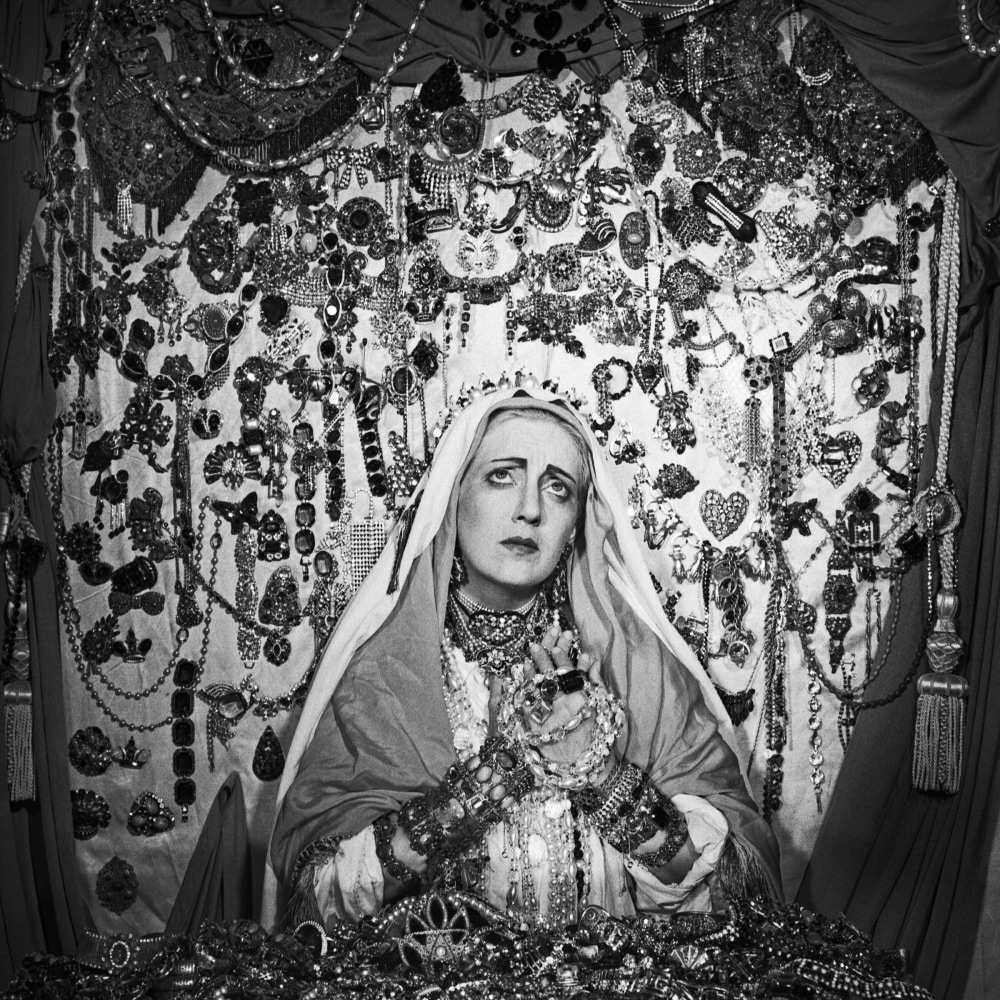
Virgin of Paste, 1983
Artforum
December 2022, Vol. 61, No. 4
The Year in Review
Andy Campbell
Steven Arnold
Fahey/ Klein Gallery
Theophany, a term that refers to the appearance of the divine in every-day human life, was at one point going to be the title for a monographic book of photographs by Steven Arnold (1943–1994). “Theophanies” was the name of Arnold’s exhibition at Fahey/Klein Gallery—apt for an artist who constantly saw gods and goddesses in the messy fabulous junk of the world. More should be unearthed about his role in the glit-tercrust innovations that drove the 1960s and ’70s counterculture of San Francisco, where he was based. Arnold was polymathic: a window decorator, a designer of psychedelic rock posters, and an innovative film programmer. Needing a venue to project his own movies, as well as works by those he admired (Jean Cocteau! Fritz Lang! Georges Méliès! Jack Smith!), Arnold began to hold midnight screenings and performances, called “Nocturnal Dream Shows,” at the Palace Theater. Here, anarcho-drag aesthetes known as the Cockettes rose to under-ground prominence, taking the stage alongside Arnold’s own theatrical flights of fancy, such as Monkey and the Whitebone Demoness, 1970, a collaboration with couturier Kaisik Wong featuring disco legend Sylvester, and the fashion ballet Gomorrah Borealis, 1984, choreo-graphed by Jennifer Narin-Smith. These efforts would reach their apotheosis in Cosmopolis, made the same year as Gomorrah: an arena-size spectacle featuring a cast of hundreds and a parade of fantastical set pieces that was realized in Kobe, Japan. This kind of theatrical excess is evident across Arnold’s black-and-white “tableau” photographs, the focus of this presentation. Like Salvador Dalí, a guiding influence and mentor figure for the multital-ented artist—and someone who gradually replaced the deep unknowing-ness and terror at the core of Surrealism with a grab bag of visual effects that veered toward the comical—Arnold used imagery that rarely dis-turbs, even as it knowingly punctures the thin scrim of propriety. Some of his aesthetic “transgressions” seem a little predictable, such as casting a white female or Black male as the lead in a crucifixion scene revising “the greatest story ever told” (Female Jesus, 1989, and Black Jesus, 1988, respectively—curiously, the third photo in this Conceptual triptych, Fag Jesus, 1990, was not included here). Or his portrait of a groom and bride as a male couple (The Wedding, 1989), wherein the wife shows off her meaty tuck. Yet this punched-up approach to staid binaries—sacred/profane, high/low, gay/straight—doesn’t undermine the enthralling visual razzmatazz of photographs such as Inseminating the Marvelous, 1987, and Connecting to the Infinite II, 1985. In these works, Arnold pushed his love of decorative density to the limit by embellishing virtu-ally every inch of set, flesh, and costume with painted lines.
Happily, the exhibition also put a focus on Arnold’s nonphoto-graphic output. His paintings are wild and (self-consciously?) tacky, yet far less visually graphic than his photographs. Take “Joan Praying” (Joan A. Quinn), July, 1991, which places the titular doyenne of West Coast cool-school art journalism at the center of a swirling, planet-laden mandala. Opalescent acrylics, sometimes thickly applied, give a thrift-store sheen to this otherwise heavenly vision. Other paintings in the show depicted more androgynous figures, many of whom resembled Pandora, Arnold’s high-school friend and longtime muse. Her face popped up across several photos in the exhibition, including Reeking with Inclinations, 1982, and Hunger for the Marvelous, 1986—affec-tionate reminders of their steadfast friendship. Pandora was hardly the only reappearing subject, as Arnold gathered around himself a coterie of like-minded souls and regularly hosted evening salons at his Beverly Boulevard atelier, which he dubbed Zanzabar Studio—but he’d always shoo his guests out early so that he could work for the rest of the night. Among his crew was Connie Parente, who was styled in one picture as the Virgin of Paste, 1983, a jewel-enhanced mourning mother of Christ. That word in the photograph’s title, paste, is a tip-off—as it clocks the arrayed brooches and pendants around Parente as flint glass, a rela-tively inexpensive and ubiquitous approximation of valuable bijous, such as diamonds. In their careful construction and clarity of vision, Arnold’s tableaux revel in a kind of visual and material concatenation. This is glamour on a budget, divinity emanating from every detail.